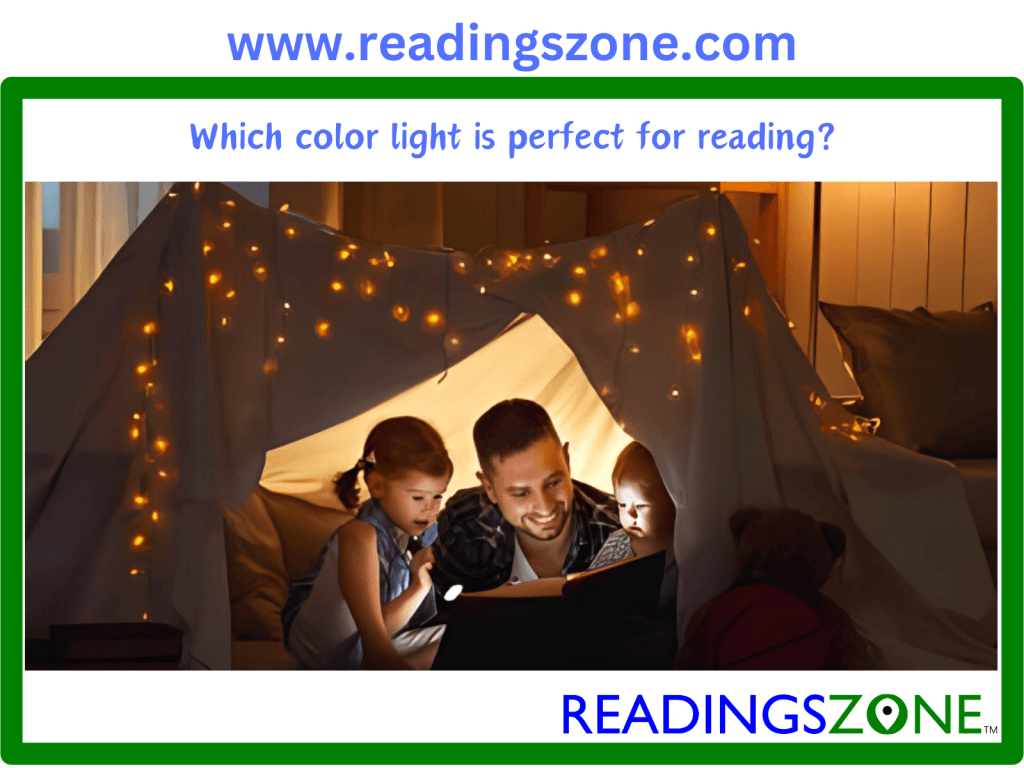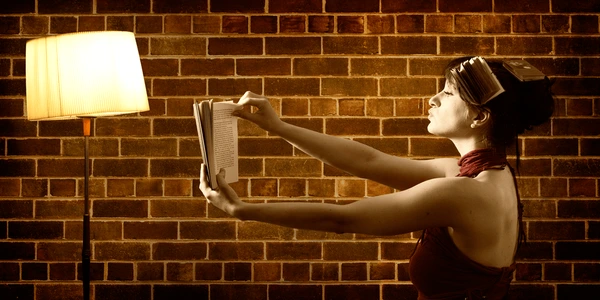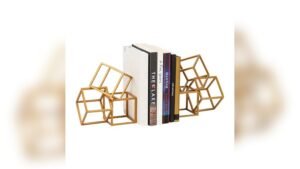Discover the Best Color Light for Reading That Boosts Your Focus & Eye Health!

Table of Contents
ToggleEver stared at a page under bad lighting and felt your eyes burn? I have. After hours of squinting at books under my old desk lamp, I decided to find out what light actually works best for reading. The color of your reading light is more important than many realize.
I want to share what I found about choosing the right reading light. It should be easy on your eyes and can even help you concentrate more. Whether you read to gain knowledge or to enjoy your time, you cannot ignore the exact benefits of reading when considering the right lighting in any situation. Right? Then scroll now!
Why Your Reading Light Really Matters
My eyes used to hurt after reading for just half an hour. Headaches would pound in my temples. Occasionally, I’d even feel dizzy. All because I was using the wrong light! It was like trying to read with sunglasses at night—just plain wrong.
The right light color can make words jump off the page like magic. Your eyes stay fresh for hours, not minutes. Your brain absorbs information rapidly. Light affects our brains in amazing ways most folks never think about.
Eye strain, tiredness, and sleep issues are the real problems here. Bad lighting doesn’t just make reading hard—it can mess up your whole day! I’ve talked to friends who thought they needed new glasses when really they just needed better light. What a game-changer when they fixed their lighting!
Scientists have been studying this stuff for years in labs across the country. They’ve found solid proof that different light colors change how alert we feel, how well we focus, and even how deeply we sleep. Picking the right reading light isn’t just about seeing better—it’s about thinking better too.
Most people grab whatever lamp is on sale without thinking twice about the light color. Big mistake! The color temperature of your lightbulb might be why you can’t focus on that novel or why you’re falling asleep during study sessions. I made this mistake for years until I learned better.
Further explore: The perfect ways to focus on reading?
The Problem: Eye Strain, Tired Brain, and Mixed-Up Sleep
Reading needs two different kinds of light. Occasionally, you need to be super awake and focused—like when you’re studying for a big test. Other times you need to relax—like when you’re getting ready for bed.
Using the wrong light at the wrong time is a big mistake! If you use bright blue light at night, your brain thinks it’s still daytime. This tricks your body and messes up your sleep. You’ll feel tired the next day and might even get sick if it happens a lot.
Using soft, yellow light when you need to focus is just as bad. It’s like trying to run fast while wearing pajamas—it just doesn’t work! Your brain starts to get sleepy when you need it to be sharp.
The Big Question: What Light Color Helps You Read Best?
There’s no one perfect light for all readings. The best light changes depending on what you’re doing and what time it is.
This article will show you two super-simple light tricks:
- The “Stay Sharp” trick—using cool white light when you need to focus
- The “Sleep Well” trick—using warm yellow or red light before bedtime
Using both tricks helps you do exceptionally well in school AND sleep like a baby at night. It’s like having a superpower that most people don’t know about!
Further explore –the adventures of candlelight reading & its amazing benefits
White Light vs. Yellow Light: The Great Lighting Debate
This is the big question everyone asks: Should you read under white light or yellow light? The answer isn’t simple because both have their pros & cons. Right?
White light feels crisp and clean. Yellow light feels warm and cozy. But which one actually helps you read better? Let’s break it down.
The Bright Side of White Lightning
“Cool white” light, especially with higher Kelvin ratings (5000K and up), resembles daylight much more than regular white light. Our bodies evolved to be alert during daylight hours, so this type of light sends a clear signal to your brain: “Wake up! It’s time to focus!”
According to the Canadian Journal of Work, Environment & Health, exposure to this bluish-white light increases alertness and attention. Your brain produces less melatonin (the sleep hormone) when exposed to this light. That makes white light great for tasks that need sharp focus.
Many students swear by white light for studying complex subjects. The brightness and clarity help with detail work. Text looks sharper. Colors appear more true. Your eyes can pick up small details better.
I tested this myself with a physics textbook. Under cool white light, the diagrams were clearer and the small print was easier to read. My focus stayed sharp for longer periods, too.
The Cozy Comfort of Yellow lighting.
Yellow light (or “warm white” at 2700-3000K) feels like sunset or firelight. It’s the color of traditional incandescent bulbs that lit homes for decades. This light has less blue in it and more red and yellow wavelengths.
Pic credit: Shutterstock
Yellow light creates a relaxed feeling. It suppresses melatonin less than white light, so it will make you less alert. But that’s sometimes desirable.
For fiction reading or relaxing with a book, yellow light creates the perfect mood. It feels less harsh on the eyes during long reading sessions. Many people find it more comfortable for extended reading.
A study in the Journal of Environmental Psychology found that warm lighting created a more relaxed atmosphere that some people preferred for creative thinking and reading for pleasure. The softer light reduced the feeling of being “on task” and allowed for more relaxed engagement with the material.
I noticed this effect when reading novels. Under the yellow light, I felt more immersed in the story. The pages looked warmer, and the experience felt more like curling up by a fireplace with a delightful book.
What Color of light is Best for studying?
When you need to remember what you’re reading, the light color becomes even more important. The best light for studying might be different from what’s best for casual reading.
People often face two opposing needs when reading. They need to be super alert for tough stuff like studying chemistry or reading tiny writing. But they also need to chill out when trying to relax with a delightful novel. Using the wrong light at the wrong time is like wearing pajamas to the gym—it just doesn’t work!
Not understanding these needs can really mess things up. Using bright white light late at night tricks your body into thinking it’s still daytime. Your sleep gets worse, and you end up tired the next day. I learned this the hard way after pulling all-nighters with bright lights—I felt like a zombie for days!
On the flip side, using soft, warm light when you need to focus is like trying to run a marathon after taking a sleeping pill. Your brain gets the wrong signal and starts to wind down instead of revving up. According to research from the Sleep Foundation, matching your light to your activity can improve performance by up to 20%!
Decoding the “Best Studying Light” Spectrum
Light color is measured on the Kelvin (K) scale. Lower numbers (2700K-3000K) produce a warm, yellow light. Higher numbers (5000K-6500K) give you cool white or bluish light.
Harvard Medical School research indicates that blue wavelengths, present in cool white light, are effective in enhancing attention and reducing sleepiness. It’s easy to see why this matters. Probably, a blue sky during the day helped our ancestors stay alert and ready to hunt.
For daytime studying, especially for technical subjects, research suggests that light in the 4000K-5000K range works best. This “bright white” or “cool white” light provides enough blue wavelength to keep you alert without being uncomfortably harsh.
I tested different light colors while studying for exams. Under 5000K light, I stayed focused longer and retained more information. The light felt energizing rather than relaxing, which was exactly what I needed for memorizing facts and figures.
The Super-Duper Study Light Secret!
Want to know what light helps your brain work like a superhero? It’s cool white light!
This special light looks bright and a tiny bit bluish—just like the sky on a sunny day. Scientists found out this is the BEST light for when you need to think hard and remember stuff.
When this cool white light touches your eyes, your brain gets a secret message: “Wake up! Time to be smart!” Your brain perks up like a puppy hearing the treat bag open!
The tiny blue parts in this light are like magic brain vitamins. They tell your body, “No sleepy feelings allowed right now!” According to the Sengled blog, that’s why LED lights with this special color help kids (and grown-ups too!) focus better on homework and reading.
Next time you need to study, look for a light that says “5000K” or “6500K” or “Daylight” on the package. It’s like wearing invisible thinking glasses that make your brain stronger!
Try it and see if you can feel your brain power getting bigger!
LED Colors and Your Brain
LED lights offer more control over light color than older bulbs. Many LED desk lamps now let you switch between different color temperatures with a button press.
Research published in the National Institute of Health found that exposure to blue-enriched light (like that found in cool white LEDs) improved cognitive performance and alertness compared to warm light. The study found that people reacted faster and paid better attention when working under cooler light.
For intense study sessions, like cramming for finals or working on research papers, a light with stronger blue wavelengths can really help you focus better. Many students say they focus better with cool white light between 5000K and 6500K.
In fact, switching to a cooler light setting on my desk lamp really helped me stay alert during late-night study sessions. I was able to focus without feeling drowsy. The blue light kept my mind alert, even when night fell.
Choosing the Best Reading Lights for Your Setup
The perfect reading light isn’t just about color. The right bulb needs to be in the right fixture, positioned the right way.
Picking the Perfect Bulb for Your Needs
LEDs have mostly replaced older bulb types for good reason. They last longer, use less energy, and give you more control over light color. But not all LEDs are created equal.
Beyond color temperature, look at the Color Rendering Index (CRI) of the bulb. This measures how accurately the light shows colors compared to natural sunlight. A CRI of 90 or higher makes reading easier. It helps text stand out and cuts down on eye strain.
A study in the Science Direct Journal showed that better lighting can help reduce eye strain when reading. The researchers found that people could read for longer without feeling as much eye strain when using high-CRI lighting.
I swapped out my old desk lamp for a high-CRI LED bulb. The change was wonderful. The pages appeared clearer, showing a stronger contrast between the text and the paper. Reading got a lot easier.
Brightness is important as well. When you read, make sure you have enough light to see clearly. Too much glare can make it difficult to focus. For most reading lamps, 450 to 800 lumens is ideal. It really depends on how close the light is to your book.
Finding the Right Fixture
The best reading light directs light onto your page without shining in your eyes. Position matters as much as the bulb itself.
Gooseneck lamps work exceptionally well because you can aim them exactly where needed. Clip-on book lights are perfect for reading in bed without disturbing others. Floor lamps that shine over your shoulder provide good coverage for larger reading areas.
Avoid having the bare bulb visible from your reading position. The direct glare causes eye strain. The light should illuminate your book, not your eyes.
I found that a gooseneck desk lamp positioned to shine from slightly behind and over my shoulder worked best. This eliminated shadows from my hand and provided even lighting across the page without glare.
Reading Before Bed Without Wrecking Sleep
Reading before bed is a popular way to wind down. But the wrong light could keep you awake long after you close your book.
What Color Makes You Sleepy? The Science of Melatonin
Blue light suppresses melatonin production. That’s helpful during the day but problematic at night when you want to sleep soon.
A study from the University of Basel (published in the Science Direct Journal) found that people who were exposed to blue-enriched white light in the evening delayed their melatonin release. Consequently, those exposed to blue-enriched white light took longer to fall asleep than those exposed to warm yellow light.
For bedtime reading, it’s best to use warm light, like 2700K or lower. Some reading lights now have special “sleep” settings. These settings reduce blue light and often feature an amber or reddish tint.
I changed to a warm amber light for reading before bed. I’ve realized that reading makes me feel sleepier. Once I turn off the light, I drift off to sleep more quickly. The warm glow felt right, just like reading by candlelight.
Eye Health in the Dark
Reading in a dark room with just your reading light creates high contrast that can strain your eyes. Having some ambient light in the room reduces this strain.
For nighttime reading, red-shifted light (like amber or warm yellow) causes less pupil constriction and adaptation issues. This makes it easier on your eyes when you turn off the light to sleep.
A study in the Journal of National Library of Medicine found that exposure to red-shifted light before bed had minimal impact on melatonin levels compared to blue or white light. The researchers suggested that red-shifted lighting was optimal for evening use to preserve normal sleep patterns.
I added a small amber night light in my bedroom to provide some ambient light while reading. This reduced the stark contrast between my reading light and the dark room, making the whole experience more comfortable for my eyes.
Your Ultimate Focus Lighting Strategy
The Main Question: What’s the Best Color Light for Reading That Helps You Focus?
Experts say there isn’t one “best” color of light for reading. The best light changes depending on the time of day and what our brains need. This analysis aims to outline a clear Focus Strategy using Cool White or Daylight lighting for optimal performance. It will also compare this with the Sleep Preservation Strategy, which uses warm amber or red lights for relaxing at the end of the day. This two-part method is important for balancing school success and long-term health.
After all my research and testing, I’ve developed a two-part lighting strategy that works amazingly well: From the source, Ledylighting, we can summarize the following findings: the strategy between 2700k and 5000k
For daytime studying and focused work:
- Use cool white light (4000K-5000K)
- Make sure it has high CRI (90+)
- Position it to avoid glare
- Aim for 600-800 lumens of brightness.
For evening relaxation reading:
- Switch to warm yellow or amber light (2700K or lower)
- Reduce brightness (300-450 lumens)
- Add some ambient light to reduce contrast
- Position to avoid direct light in your eyes
The best setup I found was an adjustable LED desk lamp with multiple color temperature settings. During the day, I use the cool white setting for studying. In the evening, I switch to the warm setting for pleasure reading. This simple change has improved both my focus and my sleep.
Smart bulbs make the job even easier. You can program them to automatically shift from cool to warm light as the day progresses, matching your body’s natural rhythms.
Final Verdict: The Dual-Part Lighting Strategy
Optimal reading light depends entirely on the intended cognitive outcome and the time of day. The best color light for reading employs a dynamic system that shifts seamlessly between high-demand focus and necessary relaxation.
Table 1: Dual-Strategy Lighting Parameters (The Final Verdict)
| Scenario | Goal | Recommended CCT (Kelvin) | Optimal Illuminance (Lux) | Wavelength Characteristics | Supporting Data |
| High Focus / Studying (Daytime) | Alertness, Cognitive Performance | 5000K–6500K (Cool White/Daylight) | 500 lx (Min 300 lx) | Blue-enriched short wavelengths present | Source |
| Relaxation / Pre-Sleep Reading (Nighttime) | Comfort, Melatonin Preservation | 1800K–2700K (Warm Amber/Red) | lx (Dimmable/Soft) | Zero or minimal blue/green light | Source |
Light Magic for Your Brain!
Want to know a super cool trick? Your brain learns what different lights mean!
If you always use bright blue-white lights when doing homework, your brain learns, “This light means it’s time to think hard!” Your brain gets ready to work as soon as it sees this light—like a dog who knows it’s walk time when you grab the leash!
If you always use soft orange lights before bed, your brain learns, “This light means sleepy time is coming!” Your body starts making special sleepy chemicals right away.
The more you stick to this light pattern, the better it works! Your brain gets super good at switching between “thinking mode” and “sleepy mode” just by seeing different colored lights.
It’s like having a secret remote control for your brain! Bright light = ZOOM! FOCUS! Warm light = calm… relax… sleep…
Try it for a week and see the magic happen!
Table 2: Correlated Color Temperature (CCT) and Psychological Effect
| Kelvin Range (K) | Color Description | Dominant Effect | Ideal Application | Physiological Basis | Supporting Data |
| 1800K – 2200K | Deep Red/Amber | Maximum Melatonin Preservation | Night Lights, Reading Before Bed | Minimal ipRGC activation | |
| 2700K – 3000K | Warm White / Soft Yellow | Relaxation, Comfort, Coziness | Leisure Reading, Living Rooms | Reduced eye strain, general comfort | Source |
| 3500K – 4500K | Neutral White / Warm Fluorescent | Balanced Alertness and Comfort | General Task Lighting, Compromise for all-day use | Moderate energy, less harsh than 5000K+ | Source |
| 5000K – 6500K | Cool White / Daylight | Alertness, Concentration, Focus | Studying, Technical Drafting, Task Lighting | Maximum ipRGC activation, melatonin suppression (desired) | Source |
Table 3: Essential Hardware Metrics for Eye-Safe Reading Lights
| Metric | Definition | Minimum Recommendation | Impact on Reading Experience | Supporting Data |
| CRI (Color Rendering Index) | Measures color accuracy compared to sunlight (max 100). | CRI 80+ (Preferably 90+) | Reduces visual fatigue and improves clarity of text and images. | Source |
| Flicker Rate | Rapid fluctuation in light output. | “Flicker-Free” | Eliminates headaches, nausea, and chronic eye strain caused by cheap LED drivers. | Source |
| Lumen Output / Lux Level | Total light output/intensity hitting the page. | 400 Lumens / 500 Lux (Adjustable) | Ensures sufficient illumination for detailed tasks without excessive glare. | Source |
| Adjustability | Ability to shift CCT and intensity. | Dimmable, Multi-CCT Modes (e.g., 1800K–6000K range) | The system allows for a seamless transition between Focus and Sleep strategies, thereby optimizing circadian alignment. | Source |
Conclusion
Ahh! The best light color for reading depends on your goal. Cool white light (4000K-5000K) boosts focus and alertness, making it perfect for studying and detail work. Warm yellow light (2700K-3000K) creates a relaxing atmosphere better suited for pleasure reading and winding down before bed.
Don’t underestimate the impact of good lighting on your reading experience. The right light can reduce eye strain, improve focus, and even help you sleep better. It’s worth investing in quality lighting that can adjust to different needs throughout the day.
I’ve transformed my reading experience by matching my light color to my purpose. My eyes feel better, I can focus longer, and I sleep better after evening reading. Sometimes the simplest changes make the biggest difference. Do you agree with me?
Frequently Asked Questions
What exactly is color temperature in lighting?
Color temperature, measured in Kelvins (K), describes the appearance of light from a bulb. Lower numbers (2700K-3000K) produce warm yellow light similar to sunset or incandescent bulbs. Higher numbers (5000K-6500K) create cool white or bluish light similar to daylight. The name comes from the color a piece of metal would glow when heated to that temperature—red at lower temperatures, moving through yellow, white, and finally blue at higher temperatures.
Can reading under the wrong light damage my eyes?
Poor lighting won’t cause permanent damage to healthy eyes, but it can cause temporary strain and discomfort. Symptoms include dry eyes, headaches, blurred vision, and difficulty focusing. These symptoms typically resolve after resting your eyes. However, consistently reading under poor lighting can make reading less enjoyable and may discourage regular reading habits. People with existing eye conditions may be more sensitive to lighting issues.
Are book lights good enough for reading in bed?
Quality book lights can be excellent for bedtime reading if they provide adequate brightness without disturbing others. Look for book lights with adjustable brightness, warm color temperatures (2700K or lower) for evening use, and flexible positioning options. The best book lights direct light onto the page without shining in your eyes or your partner’s eyes. Some newer models offer multiple color temperature options, letting you choose warmer light before sleep.
How does blue light affect sleep quality?
Blue wavelengths in light suppress melatonin production more strongly than other wavelengths. Melatonin is the hormone that regulates sleep-wake cycles. Exposure to blue light (found in daylight and cool white artificial light) in the evening can delay melatonin release by up to 3 hours, making it harder to fall asleep and reducing sleep quality. Research from Harvard Medical School shows that using warm lighting with reduced blue content in the evening helps maintain normal melatonin production and supports healthier sleep patterns.
What’s the difference between brightness and color temperature?
Brightness, measured in lumens, shows how much light a bulb gives off, no matter the color. Color temperature, measured in Kelvins, shows how light looks or its tint. You can choose bright yellow light or dim white light. These two options are separate from each other. To read well, you need enough light. Aim for 450-800 lumens, depending on how far away you are. Choose a cooler light for focus and a warmer light for relaxation. Today, many LED lights allow you to adjust each property on its own.
Conclusion
In conclusion, the color of the best studying light you choose for reading can significantly influence your focus, comfort, and reading experience. Whether you prefer the warm, relaxing glow of soft light or the energizing, bright illumination of cool light, understanding your needs and preferences is crucial. By considering factors like color temperature, reading environment, and individual perception, you can create the perfect reading environment and make the most of your literary journeys.



